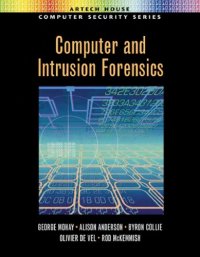
Ebook: Computer and intrusion forensics
- Genre: Computers
- Series: Artech House computer security
- Year: 2003
- Publisher: Artech House
- Language: English
- pdf
A comprehensive and broad introduction to computer and intrusion forensics, this practical book helps you master the tools, techniques and underlying concepts you need to know, covering the areas of law enforcement, national security and the private sector. The book presents case studies from around the world, and treats key emerging areas such as stegoforensics, image identification, authorship categorization, link discovery and data mining. You also learn the principles and processes for effectively handling evidence from digital sources and law enforcement considerations in dealing with computer-related crimes, as well as how the effectiveness of computer forensics procedures may be influenced by organizational security policy.
The book opens with a comprehensive introduction to computer and intrusion forensics and relates them to computer security in general and computer network security. It details the current practice of computer forensics and its role in combating computer crime, and examines the relationship between intrusion detection and intrusion forensics. What’s more, the book explores the most important new areas for future research in computer forensics. This leading-edge resource is an indispensable reference for working professionals and post-graduate students alike.
Sophisticated computer users may be able to destroy direct evidence of their crimes using computers, but given the proper tools and methods of computer forensics, indirect evidence could be marshaled to reconstruct the crime. This volume describes the nature, history, and current practice in traditional computer forensics (dealing largely with media acquisition and analysis). The authors look at the use of computer forensics in law enforcement and forensic accounting. They also describe the relatively newer field of intrusion detection and forensics, offering case studies and suggesting future research directions.
Sophisticated computer users may be able to destroy direct evidence of their crimes using computers, but given the proper tools and methods of computer forensics, indirect evidence could be marshaled to reconstruct the crime. This volume describes the nature, history, and current practice in traditional computer forensics (dealing largely with media acquisition and analysis). The authors look at the use of computer forensics in law enforcement and forensic accounting. They also describe the relatively newer field of intrusion detection and forensics, offering case studies and suggesting future research directions.
Download the book Computer and intrusion forensics for free or read online
Continue reading on any device:

Last viewed books
Related books
{related-news}
Comments (0)